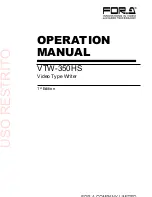
24 | SAMLEX AMERICA INC.
SAMLEX AMERICA INC. | 25
SECTION 7 |
General Information on Lead Acid
Batteries
Inverters are normally provided with a protection to shut down the output of the inverter
if the DC voltage at the input terminals of the inverter drops below a threshold of around
(i) 10V for a 12V battery, (ii) 20V for 24 battery and (iii) 40V for 48V battery. Referring to
the Discharge Curves given in Fig 7.1, the State of Discharge for various C-Rate discharge
currents for battery voltage of 10V / 20V / 40V is as follows:
- 85% State of Discharge (15% State of Charge) at very high C-rate discharge
current of C/3 Amps.
- 100% State of Discharge (0 % State of Charge) at high C-Rate discharge
current of C/5 Amps.
- 100% discharged (0% State of charge) at lower C-rate Discharge current of C/10 Amps.
It is seen that at DC input voltage of 10V / 20V / 40V, the battery is completely dis-
charged for C-rate discharge current of C/5 and lower.
In view of the above, it may be seen that a fixed Low DC Input Voltage Alarm is not useful.
Temperature of the battery further complicates the situation. All the above analysis is based
on battery electrolyte temperature of 80°F. The battery capacity varies with temperature.
Battery capacity is also a function of age and charging history. Older batteries have lower
capacity because of shedding of active materials, sulfation, corrosion, increasing number of
charge / discharge cycles etc. Hence, the State of Discharge of a battery under load cannot
be estimated accurately. However, the low DC input voltage alarm and shut-down functions
are designed to protect the inverter from excessive current drawn at the lower voltage.
7.13 USE OF EXTERNAL PROGRAMMABLE LOW VOLTAGE DISCONNECTS
The above ambiguity can be removed by using an external, programmable Low Voltage
Disconnect where more exact voltage threshold can be set to disconnect the battery
based on the actual application requirements.
7.14 DEPTH OF DISCHARGE OF BATTERY AND BATTERY LIFE
The more deeply a battery is discharged on each cycle, the shorter the battery life. Using
more batteries than the minimum required will result in longer life for the battery bank.
A typical cycle life chart is given in the Table 7.6:
TABLE 7.6: TYPICAL CYCLE LIFE CHART
Depth of Discharge
% of Ah Capacity
Cycle Life of Group
27 /31
Cycle Life of Group
8D
Cycle Life of Group
GC2
10
1000
1500
3800
50
320
480
1100
80
200
300
675
100
150
225
550
NOTE: It is recommended that the depth of discharge should be limited to 50%.
Summary of Contents for PST-600-48
Page 53: ...SAMLEX AMERICA INC 53 NOTES ...
Page 54: ...54 SAMLEX AMERICA INC NOTES ...
Page 55: ...SAMLEX AMERICA INC 55 NOTES ...
















































